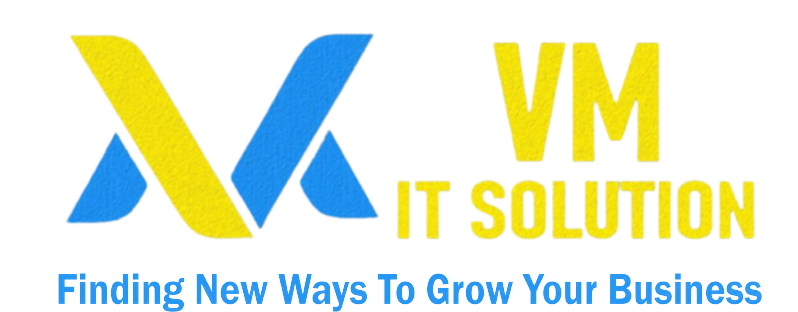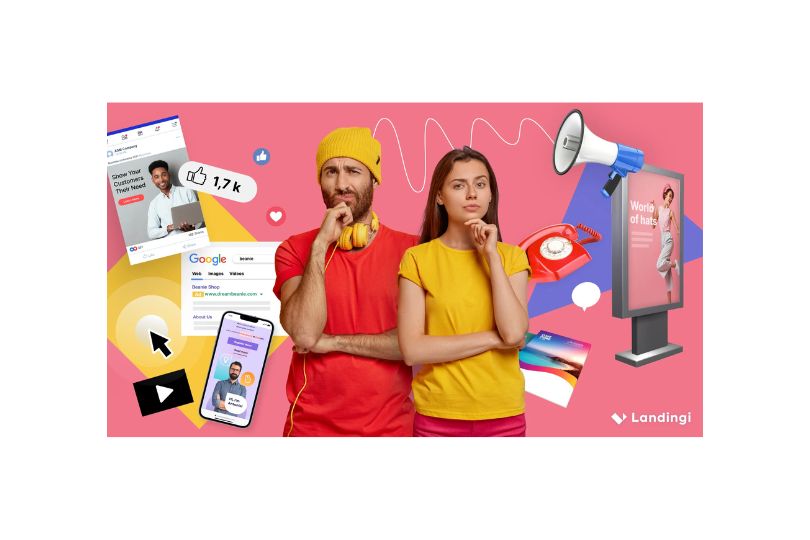Traditional marketing involves offline methods like TV, print, radio, and direct mail to reach audiences, while digital marketing uses online channels like websites, social media, and email to target and engage specific audiences in real-time.
Introduction
Marketing is the backbone of any business, helping brands connect with their audience and drive growth. Over time, marketing has evolved into two main approaches: traditional marketing and digital marketing. Traditional marketing relies on offline methods like television, radio, newspapers, billboards, and direct mail to deliver promotional messages. These strategies have been the cornerstone of brand building for decades, offering a tangible and broad reach, particularly among older demographics.
On the other hand, digital marketing harnesses the power of the internet and modern technology. It includes tools and platforms like social media, websites, email, search engines, and online ads to engage audiences. Digital Marketing Agency in Chennai excels in its ability to target specific demographics, measure performance in real time, and adapt quickly to changing trends.
Both approaches have their strengths and limitations. Traditional marketing often creates a lasting impact through its tangible presence but can be costly and less measurable. Digital marketing, while more cost-effective and highly measurable, requires constant updates to stay relevant. Businesses today often combine both strategies to maximize their reach and effectiveness, striking a balance between the enduring impact of traditional methods and the dynamic flexibility of digital innovation.
What is Digital Marketing?
Digital marketing is a broad and dynamic field that involves promoting products, services, or brands using digital technologies and online platforms. It serves as a modern alternative to traditional marketing, leveraging the power of the internet to reach, engage, and convert a global audience.
At its core, digital marketing encompasses a variety of strategies and tools designed to connect businesses with their target audience in real time. Some key components include.
Key Components of Digital Marketing:
1. Search Engine Optimization (SEO):
Improving a website’s visibility on search engines to attract organic traffic.
2. Content Marketing:
Creating and sharing valuable content such as blogs, videos, and infographics to engage audiences.
3. Social Media Marketing (SMM):
Using platforms like Facebook, Instagram, LinkedIn, and Twitter to promote brands and interact with customers.
4. Email Marketing:
Sending personalized emails to nurture leads, share updates, or encourage purchases.
5. Pay-Per-Click Advertising (PPC):
Running ads on platforms like Google Ads and social media to drive immediate traffic and conversions.
6. Affiliate Marketing:
Partnering with affiliates to promote products for a commission.
7. Influencer Marketing:
Collaborating with influencers to build trust and expand reach.
Digital marketing is data-driven, allowing businesses to measure campaign performance through analytics, understand customer behavior, and refine strategies for better results. Its adaptability and cost-effectiveness make it an essential tool for businesses of all sizes to thrive in today’s competitive digital landscape.
Why Digital Marketing?
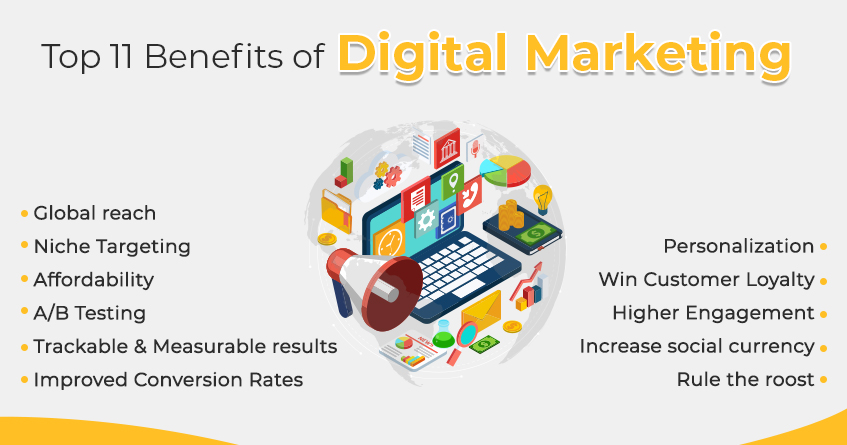
In this fast-moving world, a lot of new technologies have evolved. Digital marketing strategies are one among them. Nowadays, people can do marketing using the internet and smartphones from the comfort of their homes. These strategies are not physical, so they cut out the transportation, inventory, and other related expenses.
Due to the frequent usage of social media and the internet in general, these strategies are growing worldwide. According to DataReportal, it has been proven that 4.62 billion people use social media and 4.95 billion people utilize the internet in general.
Therefore, it makes so much sense to advertise over the internet rather than on any television or magazine.
Due to the current technological developments, digital marketing methods and strategies will always continue to evolve no matter what. There are enormous ways to do this marketing. Since they are modern, it is essential to have maximum knowledge regarding current technologies and advancements. They use the latest tactics.
There are a plethora of benefits of digital marketing over traditional marketing. Given below are some of them:
- It is simple to track audience involvement and collect their data for future use. It will enhance the algorithm of the company’s website. You can easily obtain the information when someone uses your site, follows you on social media, or messages you regarding queries.
- Businesses can advertise their services for free on many platforms. It is possible to send and receive emails without involving any cost. But in traditional strategies, it will involve a lot of money to print and send individual postcards.
- Because of the evolution in digital marketing and its wider scope, it will help businesses acquire a global audience’s attention.
What is Traditional Marketing?
Traditional marketing refers to the conventional methods of advertising and promotion used by businesses to reach their audience. It relies on offline mediums and has been a cornerstone of marketing strategies for decades. Despite the rise of digital marketing, traditional marketing remains relevant for its tangible and impactful approaches. Here’s a deeper look into traditional marketing.
Key Components of Traditional Marketing:
Print Media:
Includes advertisements in newspapers, magazines, brochures, and flyers. These methods are effective for reaching specific demographics, especially local audiences or niche markets.
Broadcast Media:
Utilizes television and radio to deliver messages to a wide audience. TV commercials are impactful for visual storytelling, while radio ads engage listeners through audio.
Outdoor Advertising:
Involves billboards, posters, banners, and transit ads to capture attention in high-traffic areas. Outdoor advertising is ideal for creating brand visibility in public spaces.
Direct Mail:
Sending promotional materials like catalogs, postcards, and letters directly to customers’ mailboxes. This method offers a personal touch and often appeals to older demographics.
Telemarketing:
Using phone calls to communicate with potential customers. It allows businesses to interact directly with their audience and provide tailored solutions.
Event Marketing:
Includes trade shows, sponsorships, and in-person events to create brand awareness and foster customer relationships.
Why Traditional Marketing?
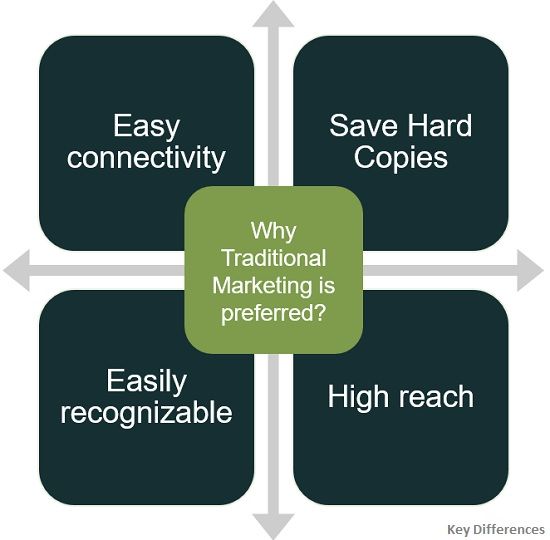
Traditional marketing vs. digital marketing is always one of the most spoken topics. Traditional marketing is defined as marketing that does not need the internet for advertisement purposes. This method has been evolving for a very long time, for decades. However, due to technological trends or advancements, its usage is very limited.
We hear and see many ads daily on the television, in the newspaper, or on the radio while casually starting our daily routine. When we go out, we can see such marketing ads on flyers all over the street. We could also notice huge banners of film ads on every street. Those film ads are also one type of marketing. It helps the movie production company to capture the attention of the people that walk across the street. Therefore, there are ads and banners everywhere in all the nations.
The languages may differ depending on the country or the region. For example, if we take Mumbai, the ads might be in both English and Hindi. So, that is how traditional marketing works. Its main objective is to attract humans in every possible way without using the internet.
For many businesses, traditional marketing strategies work better depending on the type of company they own. Their target audience would prefer the traditional one when it comes to traditional marketing vs. digital marketing.
- Traditional marketing is a very effective type of marketing if one wants to reach the older population. Many reports and surveys prove that people over 50s watch TV and read newspapers twice the time compared to the people in their 20s and 30s.
- It is a very useful type of marketing if one wants to establish or develop a business or a firm with the assistance of a larger local audience. Small businesses grow better using flyers and billboards all across the street. It is because it can attain the attention of a local audience who reside in the city.
- One huge advantage of traditional advertisements is that they get played repeatedly. But in digital marketing, people can skip them easily.
Understanding of Digital Marketing
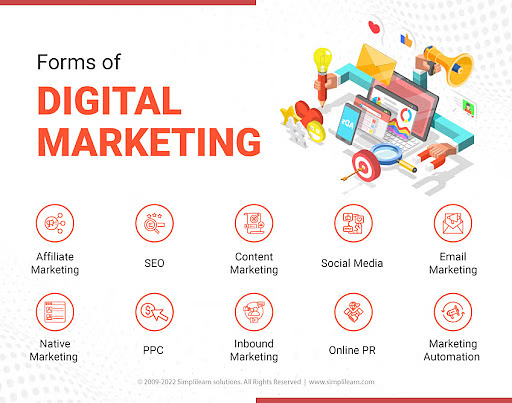
1. Search Engine Optimization (SEO)
SEO involves optimizing a website to improve its visibility on search engine results pages (SERPs). The goal is to attract organic (non-paid) traffic.
- On-Page SEO: Optimizing website content, titles, meta descriptions, and images to improve relevance for targeted keywords.
- Off-Page SEO: Building backlinks and increasing website authority through external efforts like guest blogging and influencer outreach.
- Technical SEO: Improving website speed, mobile-friendliness, and overall structure to enhance user experience and search rankings.
SEO is a long-term strategy that builds credibility and drives consistent, high-quality traffic.
2. Content Marketing
This strategy focuses on creating and sharing valuable content to attract and engage a specific audience.
- Examples of Content: Blogs, articles, videos, infographics, podcasts, white papers, and eBooks.
- Purpose: Educating or entertaining the audience, building trust, and establishing authority in the industry.
Effective content marketing addresses the audience’s needs, encourages engagement, and nurtures them through the sales funnel.
3. Social Media Marketing (SMM)
SMM uses platforms like Facebook, Instagram, LinkedIn, Twitter, Pinterest, and TikTok to connect with audiences.
- Organic Marketing: Sharing posts, engaging with followers, and creating a brand presence without paid promotions.
- Paid Advertising: Running ads targeting specific demographics to increase reach and conversions.
Social media is ideal for fostering community, showcasing products, and driving website traffic.
4. Pay-Per-Click Advertising (PPC)
PPC is a paid advertising model where businesses pay each time a user clicks their ad.
- Platforms: Google Ads, Bing Ads, and social media platforms.
- Ad Formats: Search ads, display ads, shopping ads, and retargeting ads.
PPC delivers immediate results, making it ideal for campaigns focused on sales, lead generation, or promotions.
5. Email Marketing
Email marketing involves sending targeted, personalized messages to a subscriber list.
- Types of Emails: Newsletters, promotional emails, welcome emails, and abandoned cart reminders.
- Purpose: To nurture leads, share updates, and drive customer loyalty.
Email marketing remains one of the highest ROI-generating digital marketing strategies when executed effectively.
6. Affiliate Marketing
Affiliate marketing is a performance-based approach where affiliates promote a business’s products or services in exchange for a commission.
- How It Works: Affiliates use their platforms (websites, blogs, social media) to drive traffic to the business.
- Benefits: Cost-effective as businesses pay only for results, such as sales or leads.
This strategy helps tap into a broader audience through trusted influencers and partners.
7. Influencer Marketing
Influencer marketing involves partnering with influencers (individuals with a significant following) to promote products or services.
- Types of Influencers: Micro-influencers (small audience) and macro-influencers (large audience).
- Platform Use: Instagram, YouTube, TikTok, and blogs.
Influencers build trust with their audience, making this form of marketing highly effective for brand visibility and credibility.
8. Search Engine Marketing (SEM)
SEM uses paid advertising to increase visibility on search engines. It often combines PPC with SEO techniques.
- Google Ads and Bing Ads: Popular platforms for running search and display campaigns.
SEM delivers faster results than organic SEO, making it a great option for competitive markets.
9. Display Advertising
Display advertising involves visual ads like banners, pop-ups, and videos displayed on websites, apps, and social media platforms.
- Formats: Static images, animated graphics, and interactive ads.
- Purpose: To build brand awareness and drive traffic.
Display ads are attention-grabbing and can target specific audiences through retargeting.
10. Video Marketing
Video marketing is the use of video content to engage and convert audiences.
- Platforms: YouTube, Instagram, TikTok, and embedded videos on websites.
- Content Types: Tutorials, product demos, testimonials, and live streams.
Video marketing is highly engaging, increasing retention rates and fostering trust with audiences.
11. Mobile Marketing
This focuses on reaching audiences through their mobile devices.
- Strategies: SMS marketing, push notifications, in-app advertising, and location-based offers.
- Purpose: To engage users in real-time and enhance the mobile user experience.
As mobile device usage continues to rise, mobile marketing is essential for businesses aiming to stay relevant.
12. Web Analytics and Conversion Rate Optimization (CRO)
Analytics helps businesses understand user behavior and campaign performance. CRO focuses on optimizing website elements to increase the likelihood of conversions.
- Techniques: A/B testing, improving website navigation, and enhancing landing pages.
Analytics ensures data-driven decisions, while CRO improves ROI.
13. Remarketing/Retargeting
Remarketing targets users who have previously interacted with a brand but did not convert.
- How It Works: Displaying ads to these users as they browse other websites or social media platforms.
- Purpose: To re-engage potential customers and encourage them to complete the desired action.
Remarketing increases the likelihood of conversions by keeping the brand top-of-mind.
Understanding of Traditional Marketing
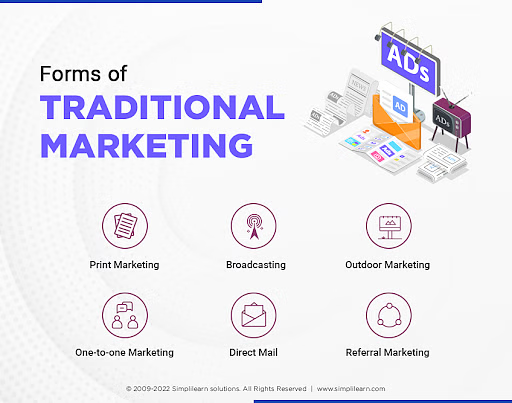
The following are some of the traditional marketing methods:
- Television commercials: One method of traditional marketing is broadcasting advertisements using TV commercials. There are millions of ads that benefit due to this form of marketing.
- Radio commercials: Radios played a vital role in the late 20th century. People who could not afford television opted for radios and CD cassettes those days. There are many different varieties of advertisements that could be broadcasted with the assistance of radios.
- Flyers: Many companies and businesses are still printing flyers to promote their services. Flyers are also called handouts.
- Billboards: Billboards contain pictures of the advertisement. They are usually found on the highways. Mostly, billboards are placed by top companies and businesses to promote their services.
- Magazine and newspaper ads: Newspaper magazines acted as one of the finest sources of obtaining information regarding anything. There are tons and tons of ads posted every day.
- Telephone and SMS marketing: These mostly include phone calls and text messages of advertisements for various businesses and their services.
- Referral: Referral is when the organization asks its employers and customers to recommend their products and services to their friends and family or neighbors.
- Direct mail: Many businesses mail their ads in postcards or notices to the people in the company’s target area or city.
The following are some of the traditional marketing methods:
- Television commercials: One method of traditional marketing is broadcasting advertisements using TV commercials. There are millions of ads that benefit due to this form of marketing.
- Radio commercials: Radios played a vital role in the late 20th century. People who could not afford television opted for radios and CD cassettes those days. There are many different varieties of advertisements that could be broadcasted with the assistance of radios.
- Flyers: Many companies and businesses are still printing flyers to promote their services. Flyers are also called handouts.
- Billboards: Billboards contain pictures of the advertisement. They are usually found on the highways. Mostly, billboards are placed by top companies and businesses to promote their services.
- Magazine and newspaper ads: Newspaper magazines acted as one of the finest sources of obtaining information regarding anything. There are tons and tons of ads posted every day.
- Telephone and SMS marketing: These mostly include phone calls and text messages of advertisements for various businesses and their services.
- Referral: Referral is when the organization asks its employers and customers to recommend their products and services to their friends and family or neighbors.
- Direct mail: Many businesses mail their ads in postcards or notices to the people in the company’s target area or city.
Pros and Cons of Digital Marketing
Digital marketing strategies are always evolving with new technology and trends like voice search and social media usage. These strategies include the most modern and latest tactics. But, as with traditional marketing, there are some areas where digital marketing thrives and others where it doesn’t.
Pros
- Data and audience involvement can be tracked instantly. When someone clicks on a link to your site, reads an email, or follows you on social media, you have that information immediately. You can draw numerous insights from this data, including which type of content works best for a specific audience, which mediums are the most effective, and even what time of day receives the best engagement.
- Digital marketing strategies incur a much lower cost. Sending out an email campaign can save a lot of money compared to printing individual postcards and paying for postage on each.
- It works well for more global or scattered audiences because of the broad scope of digital marketing.
Cons
- Some internet users have ad blockers, so they’ll never see pop-ups or banner ads. Other times, ads can be skipped or removed if a user pays for premium services (e.g., Spotify, Hulu, Twitch).
- Because new technology and trends emerge so frequently, digital marketing tactics need to be evaluated and reevaluated for effectiveness continually what works well one day may be irrelevant the next. However, this can be combatted with a strong foundation in digital marketing basics.
Pros and Cons of Traditional Marketing
When comparing traditional marketing vs. digital marketing, traditional methods are often viewed as outdated or irrelevant. However, many of these tactics are still useful and effective today.
Depending on the business and target audience, traditional marketing methods may be the better choice. To help discern if traditional marketing is right for your business, here are some pros and cons.
Pros
- If you want to reach an older demographic, traditional marketing can be very effective. It has been reported that audiences age 50+ spend almost twice as much time reading the newspaper and watching TV as compared to those ages 21-34.
- This type of marketing strategy usually works best for businesses looking to build a larger local audience. A small business would be better off competing for attention through billboards, flyers, and events rather than trying to compete for digital space against larger businesses.
- TV or radio commercials will play multiple times and remind the audience of the business, whereas digital marketing items may be skipped through or blocked (e.g., clicking “I don’t want to see this” on social media ads, or skipping through ads before YouTube videos).
Cons
- Printing postcards to send out even to just a local audience can be expensive, and there is no guarantee that the recipient is interested in your business or the product/service you offer.
- Traditional marketing methods can take weeks or months to yield results and data. You can’t tell when someone has read your newspaper ad unless they decide to follow-up. Even then, without a survey, you won’t know if the ad was the reason for the follow-up.
Digital Marketing vs. Traditional Marketing – Comparison

Here is a detailed comparison of Digital Marketing vs. Traditional Marketing which can help brands better understand the two.
| Aspect | Digital Marketing | Traditional Marketing |
|---|---|---|
| Definition | Uses online platforms and digital technologies for promotion and engagement. | Uses offline methods like TV, print, and radio for brand promotion. |
| Reach | Global reach with no geographical limitations. | Limited to specific regions unless broadcasted widely. |
| Cost | More cost-effective; suitable for small and large businesses alike. | Generally expensive; requires significant investment for broad campaigns. |
| Targeting | Highly specific targeting based on demographics, interests, and behaviors. | Broad targeting with less personalization. |
| Interactivity | Enables two-way communication through comments, messages, and feedback. | One-way communication; no direct interaction with the audience. |
| Measurability | Detailed analytics and real-time tracking of performance. | Difficult to measure ROI and campaign effectiveness. |
| Flexibility | Campaigns can be easily modified or updated in real time. | Changes are challenging once a campaign is launched. |
| Mediums Used | Websites, social media, email, search engines, mobile apps, and digital ads. | TV, radio, newspapers, magazines, billboards, brochures, and direct mail. |
| Engagement | High engagement through likes, shares, and comments on online platforms. | Limited engagement; relies on audience recall and indirect responses. |
| Speed | Quick setup and real-time updates to campaigns. | Longer planning and execution timelines. |
| Accessibility | Accessible through any device with an internet connection. | Requires physical access to print materials, TV, or radio. |
| Longevity | Content remains available online indefinitely (e.g., blogs, videos). | Ads and campaigns have a fixed lifespan (e.g., newspaper ads for one issue). |
| Audience | Effective for tech-savvy and younger demographics. | Better suited for older generations or those less active online. |
| Personalization | High level of personalization through tailored ads and content. | Limited personalization options. |
| Examples | Social media ads, SEO, email marketing, PPC campaigns, and influencer marketing. | TV commercials, radio jingles, billboards, and print ads in newspapers/magazines. |
Traditional Marketing to digital marketing: the paradigm shift
The shift from traditional marketing to digital marketing represents a fundamental transformation in the way businesses engage with their audiences, driven by technological advancements and evolving consumer behaviors. This paradigm shift is characterized by several key changes.
1. Consumer Behavior Evolution
- Traditional Marketing: Audiences were passive recipients of messages via TV, radio, and print.
- Digital Marketing: Consumers now actively seek information, research products online, and interact with brands through social media and websites.
2. Global Reach vs. Localized Efforts
- Traditional Marketing: Limited by geographical boundaries, relying on localized campaigns.
- Digital Marketing: Offers a global platform where businesses can reach audiences worldwide instantly, breaking physical barriers.
3. Data-Driven Decision Making
- Traditional Marketing: Relies on assumptions and estimates for targeting and measuring success.
- Digital Marketing: Uses advanced analytics tools to gather real-time data, providing insights into customer behavior and campaign performance.
4. Cost Efficiency and ROI
- Traditional Marketing: High costs for production and placement, such as TV ads or billboards, with unclear ROI.
- Digital Marketing: Cost-effective strategies like PPC, social media, and email marketing provide measurable ROI and scalability.
5. Personalization and Engagement
- Traditional Marketing: Offers limited opportunities for personalization or interaction.
- Digital Marketing: Delivers highly personalized content through tools like retargeting and dynamic ads, fostering two-way communication.
6. Speed and Adaptability
- Traditional Marketing: Campaigns take longer to plan, create, and implement, with minimal flexibility to adjust once launched.
- Digital Marketing: Campaigns can be created and updated quickly in response to market trends or feedback.
7. Accessibility and Convenience
- Traditional Marketing: Audiences need access to physical media like newspapers or TVs.
- Digital Marketing: Content is accessible anytime, anywhere, on various devices, offering convenience to consumers.
8. Shift in Advertising Channels
- Traditional Marketing: Dominated by TV, radio, print, and outdoor ads.
- Digital Marketing: Leveraging websites, social media, email, search engines, and mobile apps.
Why the Shift Occurred
- Rise of the Internet: Made information more accessible and enabled global connectivity.
- Smartphone Adoption: Increased mobile internet usage, making digital platforms integral to daily life.
- Demand for Engagement: Consumers expect interaction and instant responses, which traditional channels cannot provide effectively.
- Cost Pressure: Digital marketing’s lower costs attracted businesses, especially small and medium enterprises.
Impact of the Shift
- Businesses can now target audiences with greater precision, engage in real-time conversations, and track campaign effectiveness.
- It has democratized marketing, enabling small businesses to compete with larger corporations.
- Consumers enjoy more personalized experiences and the ability to interact with brands directly.
Digital Marketing vs. Traditional Marketing: What’s the Difference?
When it comes to marketing, there are two main types: digital marketing and traditional marketing. But what’s the difference? Digital marketing refers to any form of marketing that takes place through digital channels, such as the internet, email, or mobile devices. It’s become increasingly popular in recent years due to the proliferation of digital devices and the rise of online networking. Traditional marketing, on the other hand, refers to any form of marketing that takes place offline, such as print advertisements, television commercials, or radio ads. It’s still a popular method of marketing, especially for larger businesses with more resources.
Which One is Better?
So, which strategy wins when comparing traditional marketing vs. digital marketing?
The short answer: it depends.
The long answer:
Digital marketing is probably the best option for most. If you want to reach a particular group of people, wherever they may be, while keeping costs low, go with digital marketing. Doing so will also allow you to collect valuable information on your audience immediately so that you can create even more effective marketing campaign.
However, there is still a place for traditional marketing. If you want to reach an older audience or a local audience, traditional marketing methods may be more productive and stand out better than digital marketing methods. Though these methods may seem “old,” the reality is that they’ve stuck around for a reason. They work!
When considering which marketing strategy is best for your business, consider your audience, where they get their information from, and use that to make your decision. When deciding between traditional marketing vs. digital marketing, it’s not necessarily true that one is simply better than the other as they serve different purposes. The bottom line is that you need to fully understand your business and your audience to pick the strategy that’s better for you.
Which Type of Marketing Should You Use?
Digital marketing is generally more cost-effective and can be more targeted, while traditional marketing can be more effective at reaching a larger audience. It’s important to consider your budget and target market when deciding which type of marketing to use.
Ultimately, the best type of marketing is the type that best suits your business and your goals.
FAQs
1. What are a few types of modern marketing techniques?
Digital marketing occurs via various platforms. Some of them are:
- SEO – Search Engine Optimization
- PPC – Pay-per-Click
- Affiliate marketing
- Marketing analytics
- Mobile marketing
- Email marketing
- Social media marketing, etc.
2. How effective is traditional marketing?
It is proven that traditional advertising is more efficient than digital marketing while creating brand awareness and consideration. It also helps acquire new customers with the help of traditional marketing techniques.
Want to Get into the Exciting Field of Digital Marketing?
While traditional marketing still has a place, let’s be clear, digital marketing is the future. Younger generations like Gen Z have not known a time without smartphones, and they are starting to enter the workforce—backed another generation that will be even more digital. The fact is that every company and brand needs a digital marketing strategy to survive in today’s world, so there are plenty of career opportunities. If you are interested in joining this exciting field, check out Simplilearn’s post graduate in digital marketing program in partnership with Purdue University, which provides comprehensive training on everything you need to know to thrive.
